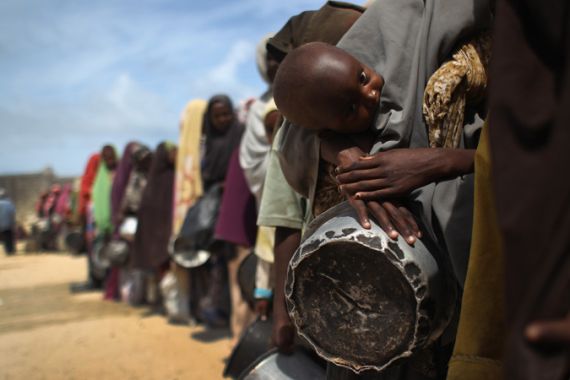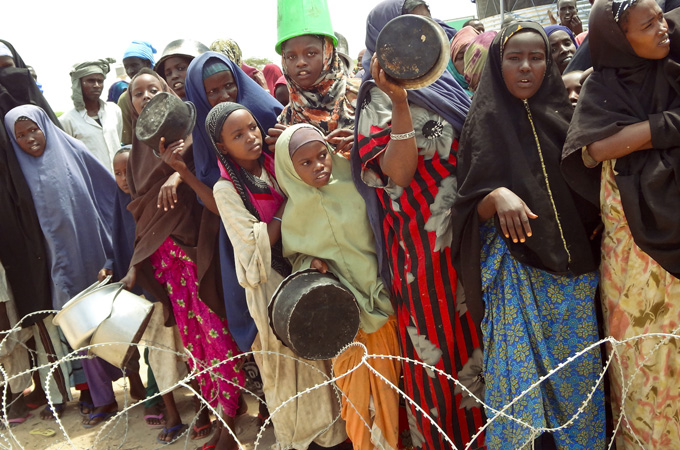Ending the famine in Somalia
The blame game should stop and the international community must address the situation before it gets too late.

 |
| Somali women wait in line to receive emergency food at Badbado IDP camp set up in the capital, Mogadishu [EPA] |
Unfortunately, the famine in Somalia has killed tens of thousands of people (mostly children) and it threatens millions more. Facing a problem of this magnitude, this is not the time for a blame game. It is the time for action in order to save as many people as possible from the famine in Somalia.
The United States-funded Famine Early Warning Systems (FEWS) has alerted national and international players in the East Africa region about the crisis at least six times over the last year. But the international community has ignored these warnings.
Keep reading
list of 4 itemsPalestinian Prisoner’s Day: How many are still in Israeli detention?
‘Mama we’re dying’: Only able to hear her kids in Gaza in their final days
Europe pledges to boost aid to Sudan on unwelcome war anniversary
Only when the international media started to broadcast horrific images of the starving Somalis did the world realise the severity of the situation. As the FEWS predicted, many Somali pastoralists and agro-pastoralists have lost their livelihood in the region, thus facing mass starvation.
Yet the long drought is not the sole cause of the famine in Somalia. Desertification, poverty, conflict and climate change comprise the background causes as well. Moreover, as Nobel laureate Amartya Sen famously argues, the problem is not limited to the shortage of the food supply.
In fact, in Somalia, some food is still available in big cities, but people do not have the ability to buy it because the price of food tripled last year.
Furthermore, as Al Jazeera revealed, the World Food Programme stockpiled huge amounts of food in stores in Mogadishu while people starved in the same neighbourhood.
Lack of state
The leading cause of the famine is the absence of a functioning state in Somalia. The current drought has affected other states such as Uganda, Kenya and Ethiopia. Although communities there are vulnerable, none of these countries face the same level of starvation taking place in stateless Somalia.
Crisis is not new to Somalia too. But the former military government managed the protracted drought that hit the central and northern regions of the country in the 1970s well. It has moved many people from those areas and settled them in the southern regions, particularly the lower Shabelle (the centre of the current famine).
Had there been a functioning state in Somalia now, the current famine would have been managed much better.
For now, the Al-Shabaab extremist group controls most of the regions that famine has affected. Although it is a weak, heterogeneous and unpopular organisation that has outlived its time, Washington’s strategy to defeat it failed.
The Obama administration has relied on foreign troops, has prevented aid agencies from working in the regions that are under Al-Shabaab control, and has empowered tribal militias. These policies have backfired and only contributed to the suffering of the Somali people.
Crucial steps
The next two months are crucial in containing and ending the famine in Somalia. For this to happen, steps must be taken that are absolutely necessary.
First, the United Nations Security Council should invoke the responsibility to protect (R2P). Both conditions of lack of will and capacity from domestic actors are present in Somalia. The Somali government does not have the capacity to protect its own people. Al-Shabaab, on the other hand, refused to let some aid agencies work in its sphere of control.
Therefore, a Security Council resolution and action towards this end would be helpful. It would create a sense of urgency among donors and it would provide legitimacy and direction to the relief efforts in Somalia. Such a resolution would send a strong signal to domestic actors that the international community will not allow any group to hold Somali civilians hostage.
Most importantly, a decision to invoke R2P would refocus the United Nations and the Somali government’s misplaced priorities and force them to get its act together. Common sense suggests that any responsible administration would put all of its energy in rescuing the starving people and stabilising the country. Unnecessary political conferences and overseas trips that have neither utility nor urgency must stop.
Second, the United States should give aid agencies the flexibility they need in order to distribute food to the starving people. Washington’s previous decision to prevent aid agencies in working Al-Shabaab-controlled areas contributed to the famine. The Obama administration should facilitate aid workers to do their job.
Third, the international community should start air-dropping food in the areas that are not now accessible to aid agencies. The pictures we have seen in the media are largely coming from Mogadishu and Dadaab. But the media has not reached the rural areas in Somalia. Evidently, many people could not reach feeding centres and major cities.
Finally, local aid agencies and Somali money transfer companies should be used in order to deliver food and open feeding centres in rural and small towns in Somalia. Local aid agencies understand conditions on the ground and can navigate their way in distributing food.
Moreover, money transfer agencies can be used in delivering aid, because they have branches throughout the country and can open and manage feeding centres easily.
So far, the Somali diaspora has shown unity and leadership in combating the famine by sending donations to the starving people. They have also raised the awareness of their host countries – seven Somalis walked the 300km from Calgary to Edmonton to raise awareness of the famine and collect some funds.
Such efforts should be encouraged and supported as well.
In short, Somali people need all the help they can get in this critical time. For now, Somalis and the international community must unite to distribute the food and rescue as many people as possible.
But in the long run, the creation of strong national state institutions is imperative.
Afyare Elmi is an assistant professor at the Qatar University’s International Affairs Department and he is the author of Understanding the Somalia Conflagration.
The views expressed in this article are the author’s own and do not necessarily reflect Al Jazeera’s editorial policy.
